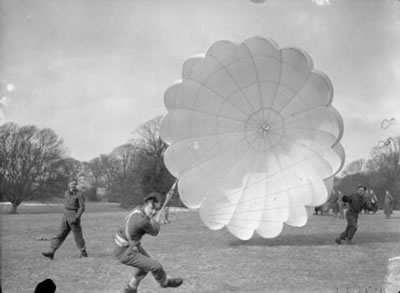The 1st Independent Polish Parachute Brigade
(1 Samodzielna Brygada Spadochronowa)
How Much Was A
Parachutist Paid?
Perhaps, like me, you thought that the Polish troops were either volunteers or conscripts and that it was not paid work. Not so.
An account from Rymazeski tells us that when the Polish Army was based in the Middle East the call went out for volunteers to join. He states that many joined "because the pay was better".
At that time (late 1941), parachute unit members in the UK British Army were receiving 4 shillings a day "danger money".
General Sosabowski was well aware of this and so put in a request to General Sikorski (who was the Commander In Chief) to have similar pay for the members of the 1st Independent Polish Parachute Brigade.
 © Karta
© Karta
Eventually, agreement was arrived at and the full pay became available for fully qualified parachutists who were combat ready.
Those that were training though, received 2 shillings a day from the day that training commenced (pay was backdated as applicable). Upon passing and being combat ready they went up to the full amount of 8 shillings a day.
If the soldiers condition changed at any time i.e unable to parachute due to injury etc, then the pay was stopped. Similarly, if he no longer served in the parachute brigade then the pay was stopped on the day he left.
To ensure that the funds paid to the 1st Independent Polish Parachute Brigade were used wisely, General Sosabowski had each parachutist undertake a full 7 hour physical assessment once per month along with a "field assessment" that lasted 2 hours.
As if this wasn't enough, once every quarter they also were re-assessed and did;
- A 3km march
- Ditch jumping (where the ditch was 2.5 meters wide.
- 6 jumps from a parachute tower (or 1 jump using the balloon or an aeroplane jump)
The parachutists were initially paid monthly in arrears (for officers) and every 10 days in arrears for all other ranks. In time, this was simplified to just one payment on the 11th each month.
Please Donate!

Uncover The Past - Support The Future
Please don't "grab & go"! Each year, 12,000 people visit this website to trace their Polish ancestry, uncover family stories, and connect with their roots. I believe that history should be accessible to all - but keeping this website alive since 2017 comes at a personal cost to me, 8 years @ £1000 per year (website mgt fees) has left an £8000 dent...with only £380 in total donated up to 27/11/25 😱😱😱.
Every detail you uncover and every story you piece together helps you piece family history together. Please donate if you found the existing information on this site useful, help me keep the site alive! Thanks! Jason Nellyer (Researcher & Site Owner)